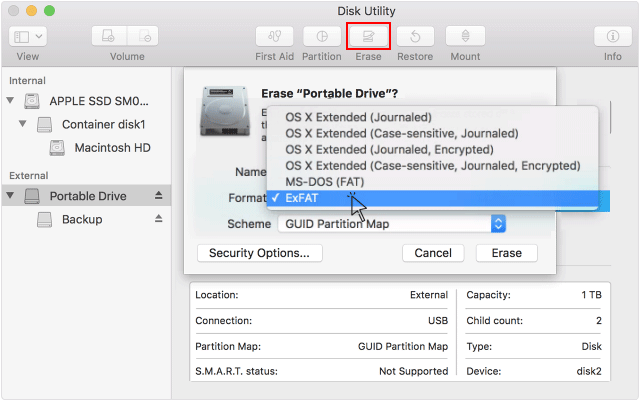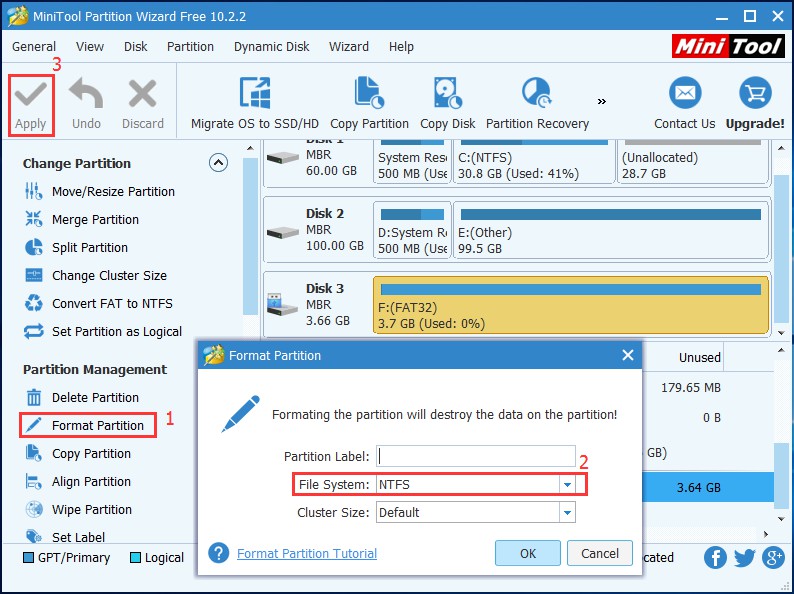However, larger flash drives are often sold with NTFS format. Such devices must be reformatted on the PC/Mac to use them in the vehicle. Formatting deletes all data on the device. Important: Only Tesla. Windows uses NTFS and Mac can't write files to volumes with NTFS format. So, if you want to use a USB flash drive or an external hard drive with NTFS format on Mac, you should first reformat the devices to the Mac OS Extended file system. It is the best way to ensure full Mac compatibility of a new external hard drive or flash disk.
by Shirly Chen, updated on 2019-07-08 to Mac Data Wipe
USB drives and external hard drives on macOS Catalina are used for storing and backing up important data such as photos, videos, audios, images, notes, messages, music files, PDF files, Word documents, among other files. Sometimes, we delete some of these files because we do not need them, but they remain somewhere and can be retrieved from the same device or using a data recovery software. In some cases, we want to carry out this task in a permanent way, but we do not have any idea about how to do it. Here, we will show you how to permanently format and delete your files and so prevent a possible data recovery.


Three ways to format USB flash drive, external hard drive on macOS Catalina
There are many tools can help you format USB flash drive, portable hard drive, memory card or other storage device on macOS Catalina. Here, we will show you three ways to format USB flash drive, external hard drive, etc on macOS Catalina.
1. Format USB flash drive/external hard drive with Disk Utility on macOS Catalina
Disk Utility is a built-in disk management application on macOS Catalina. You can run it to format the USB flash drive, external hard drive on macOS Catalina. But, the formatted data can be recovered by Mac data recovery software.
2. Format USB flash drive/external hard drive with MacClean360 on macOS Catalina
MacClean360 also offers disk management tool, disk manager. This tool can help you securely and quickly format USB flash drive, external hard drive under macOS Catalina. The formatted data also can be recovered by Mac data recovery software.
3. Format USB flash drive/external hard drive and permanently wipe data on macOS Catalina
If we are planning to sell, donate or dispose our USB flash drive or external hard drive to another person, we should format them to clean up all data, even this is also an option if we want to recover their complete storage. Maybe, we do not know how to format our device properly and permanently to avoid retrieving our private files. here, we will help you choose the best way to format/wipe your device on macOS Catalina; you can use DoYourData Super Eraser for Mac, which is highly recommended by users.
DoYourData Super Eraser for Mac can help you format USB flash drive, External hard drive or other device on macOS Catalina. And it will permanently wipe all data from the USB flash drive or device. Once the USB flash drive/external hard drive is formatted by this software, all data on the USB flash drive/external hard drive will be gone forever, can’t be recovered by any data recovery method. So, before you format your USB flash drive or external hard drive with DoYourData Super Eraser for Mac, you’d better back up your data to a safe location.
The steps to format USB flash drive/external hard drive on macOS Catalina are pretty simple.
Step 1: Download DoYourData Super Eraser for Mac.
Download and install this disk formatting tool for macOS Catalina. Then run it from Launchpad. And connect the USB flash drive or external hard drive with your Mac.
Step 2: Format and wipe the USB flash drive/external hard drive on macOS Catalina.
Choose mode “Wipe Hard Drive”, then choose the targeted device and click on “Wipe Now” button. Then the selected USB flash drive or external hard drive will be formatted and all data on the selected device will be permanently erased.
The three ways above can help you securely and easily format USB flash drive, external hard drive on macOS Catalina. We strongly recommend DoYourData Super Eraser for Mac. It will help you format and wipe data before you sell, donate, or give away your hard drive, USB flash drive, memory card, digital camera, portable hard drive, etc.
Related Articles
Permanently and securely erase data from hard drive or external storage device under Mac OS with certified data erasure methods.
Hot Articles
Nowadays, when you buy a USB drive, you can use it right out of the box with your Mac. However, unless it’s been designed for use with a Mac, it won’t be formatted using macOS’ preferred file system (either Mac OS Extended or APFS, depending on which version of macOS you’re running).
That’s because most of the computers in the world run Windows, and Windows uses a different file system, usually one known as Fat32. Drives formatted as Fat32 can be read from and written to by macOS, but it’s not optimal and you’re more likely to run into problems than if you use macOS’ native format. So, if you’ve bought a USB drive that’s formatted as Fat32, or any other format other than Mac OS Extended (also known as HFS+) or APFS, here’s how to format a USB drive on Mac. It’s exactly the same procedure if you need to reformat a flash drive on a Mac.
How to format a USB drive on a Mac
1. Plug the drive into a USB socket (if you have a recent MacBook or MacBook Pro that only has USB-C connectors, you’ll need a USB-C to USB-A adaptor).
2. Open a new Finder window and click on the drive. Make sure it has no files on it that you need. The process of reformatting it will wipe all the data from it.
3. Once you’ve copied any files you need from the USB drive to your Mac, go to Applications>Utilities and double-click on Disk Utility.

4. Click on the USB drive in the sidebar and then choose Erase from the toolbar at the top of the window.
5. In the window that drops down type a name for the formatted drive in the box next to Name.
6. Choose a format from the dropdown menu.
7. If you have previously stored sensitive data on the drive, click the Security tab.
8. Choose a security level using the slider. The further to the right you move the slider, the more ‘passes’ the erase tool will make and the more securely files will be deleted. However, it also increases the time it takes to format the drive quite considerably.
9. Click Ok then click Erase.
Tip: You don’t need to erase a whole drive to delete files securely. If you have confidential files or sensitive data you need to remove from your Mac completely, you should use CleanMyMac’s File Shredder. It’s specifically designed to securely delete sensitive data and will render it unrecoverable. You can download CleanMyMac X for free here.
Which format to choose?
If your Mac is running macOS High Sierra or later, you have two options for file formats: APFS and Mac OS Extended. Which should you choose? The key point is that disks formatted as APFS won’t be recognized by Macs running versions of macOS older than High Sierra. So if you think you might need to plug the USB drive into a Mac running an older version of macOS, format it as Mac OS Extended.
APFS is optimized for SSD (solid state drive) such as flash drives, so if you reformat a flash drive on a Mac, you should definitely choose APFS (unless you plan to use it with a pre-High Sierra Mac, of course). Even on hard drives, however, APFS is faster and more reliable than Mac OS Extended.
Finally, if you plan to use the USB drive as a destination for Time Machine backups, choose Mac OS Extended. Time Machine can’t currently back up to an APFS disk and if you select one for use with Time Machine, it will offer to reformat it as Mac OS Extended. You can, however, backup an APFS formatted disk to a Mac OS Extended Time Machine drive.
How to format a USB drive to FAT32 on a Mac
Create Bootable Usb On Mac
The main reason for formatting a USB drive as Fat32 on a Mac is that you want to be able to use the drive on a Windows PC, as well as a Mac — perhaps to transfer files between the two machines. You may also be preparing the drive for use as, say, a storage device for a media player or to record TV programmes on a TV with a USB port.
The fact that Fat32 can be read from and written to on both Mac and Windows makes it very versatile. However, there is a significant limitation — individual files have a maximum size of 4GB. So, if you’re using the USB drive to store large video files, you may run into trouble. There is a solution, however, exFAT. Unlike FAT32, exFAT doesn’t have a maximum file limit. Better still, it can be read from and written to on any Mac running Mac OS X Snow Leopard or later and on Windows.
To format a USB drive in FAT32 or exFAT:

1. Plug the USB drive into your Mac.
2. Go to Applications>Utilities and launch Disk Utility.
3. Click on the USB drive in the sidebar in Disk Utility.
4. Click Erase in the Disk Utility toolbar.
5. Type in a name for the formatted disk.
6. Click on the Format menu and choose either MS-DOS (FAT32) or ExFAT.
7. Click Erase.
Best Flash Drives For Macs
Your USB drive will now be erased and re-formatted as either FAT32 or ExFAT, depending on the format you chose in step 6.
How to manage your drives easily
If you look for a quick and easy way to manage your drives, try using CleanMyDrive 2. With its help, you can drag-and-drop files directly to any drive, clean hidden junk from external drives, and check disk stats. It works for all drives, including USB drives, SSD, SD cards, external hard drives. All the drives will be at hand in the menu bar, so you can get to see types of drives you have and manage them easily. CleanMyDrive is absolutely free to use, so download it on the Mac App Store and enjoy!
It’s very easy to format a USB drive on a Mac using Disk Utility. There are a couple of things you should keep in mind, however. The first is that when you format and disk, you will erase all the data currently on it. So if you need that data, make sure you copy it onto another disk before you start. Secondly, there are several formats to choose from, each with advantages and disadvantage. Use the guide above to help you decide which is right for you.